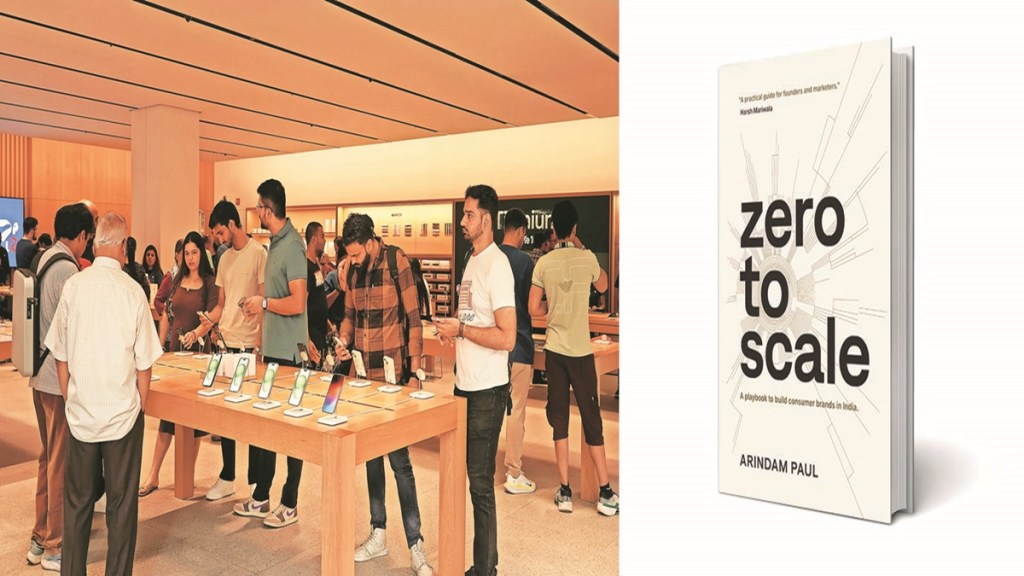By Srinath Sridharan
There are two kinds of business books in circulation today. The first kind is written by consultants and academics who lean on case studies to present neat frameworks. The second kind is written by entrepreneurs who have actually built something from scratch and are willing to share what worked and what failed. Zero to Scale firmly belongs to the second camp. Arindam Paul, part of the founding team at Atomberg, has not only witnessed but shaped the company’s rise from a fledgling startup into a consumer brand with a turnover in excess of Rs 1,000 crore. That scale is lived experience, and this is what gives the book its weight and credibility.
The publisher, Wyzr, has played a smart hand here too. Its founder, an alumnus of IIM Indore, has drawn on that network to commission a phenomenal book by another alumnus, Arindam himself. There is an interesting business model emerging— working with Unicorn CXOs as authors, giving them a platform to showcase their case studies in a way that conventional (and often snooty) academic journals have yet to recognise. It is also a quiet reminder to commissioning editors in the business who keep chasing only marquee executives or manuscripts backed by large marketing budgets. Sometimes the most relevant stories are being lived and told by people building companies in real time, not only by retired CEOs or academic celebrities.
Practical Lessons from a Founder’s Journey
Paul makes no attempt to write a glossy memoir. This is presented as a playbook, and it feels like one. The book moves through the lifecycle of a consumer brand—spotting the right category, designing the first product, setting up distribution, scaling customer acquisition, building brand salience, and managing the grind of operations. Each stage is explained through Atomberg’s journey, with anecdotes of mistakes and corrections. What makes the writing stand out is its clarity and practical tone. There are no abstractions here.
You get sharp warnings, like why you should not rush into offline retail until your product has genuine pull, or why you must never pour money into large brand campaigns until distribution is ready to absorb the demand.
Navigating the Indian Consumer Market
For readers unfamiliar with the challenge, it helps to understand the Indian backdrop. Scaling a consumer brand here is very different from doing so in the United States or Europe. The market is vast but fragmented. Consumer behaviour varies sharply across regions. Distribution channels are messy, shaped as much by relationships and ground execution as by strategy. While digital commerce has opened up opportunities, offline still dominates in most categories. For a brand to succeed, it must learn to balance modern marketing with the unglamorous grind of supply chain and sales.
Paul addresses this reality head on. He is particularly strong when writing about distribution. His framing of PMF into a distinctly Indian PPCMF—product, price, channel and market fit—stands out for its practicality and robustness. Equally sharp is his question, “what’s your wedge?”, a simple but powerful way to force clarity on what truly differentiates a product. He notes that getting into retail is easy, staying there is hard.
Shelf space, once lost, is almost impossible to regain. His insistence on weighted distribution, making sure enough outlets in a geography carry your product before spending on advertising, is both disciplined and practical. It is the kind of guidance that can save founders crores and years of wasted effort.
Marketing receives equally candid treatment. Paul recounts how Atomberg initially grew through digital performance marketing, riding on lookalike audiences on platforms like Facebook. That tactic worked when competition was thin and costs were manageable. He is candid, that today’s digital environment is crowded, expensive, and unforgiving. Over-reliance on paid digital channels, he argues, is a recipe for diminishing returns. His prescription is to build brand alongside performance, to invest in how consumers perceive your product rather than just in clicks and conversions.
What makes these lessons resonate is Paul’s honesty about what went wrong before things went right. He is willing to talk about missteps—channels entered too soon, money wasted on premature campaigns, and the pressure of scaling faster than the organisation was ready for. That candour is refreshing in a genre where too many founder-authors are tempted to write hagiographies of their own journeys.
The book’s biggest strength lies in this mix of clarity and credibility. It covers essentially consumer behaviour, distribution models and mixes, customer acquisition, brand and communication, organisational culture and nuances and, importantly, measurements. The writing is plain, free of jargon, and accessible even if you do have an MBA. The lessons are actionable. Founders and marketers will see principles they can fold into their campaigns. Students will discover frameworks that are both simple and relevant. Too many business schools continue to recycle old case studies and outdated slides that miss the reality of India’s changing consumption patterns. If this book does not push them to rethink their teaching material, it should at least nudge them to pay more attention to what is happening in the market rather than what was written in journals two decades ago.
That is part of what makes Zero to Scale double as an educator. If you are not even a student of marketing or branding, the book is your crash course in how India buys, sells, and consumes in 2025. Because it is rooted in Atomberg’s journey, some of the lessons may not apply directly to all the industries. Nor does it claim to offer it.
Yet these are minor caveats in what is otherwise a significant contribution. The timing of the book could not be better. India is seeing an explosion of new consumer brands in sectors ranging from personal care to packaged foods. Hundreds of founders are trying to build the next big story, often stumbling over the same hurdles: poor distribution discipline, premature marketing spends, or blind faith in digital acquisition. At a time when capital is tighter and competition fiercer, advice that is this pragmatic is worth its weight in gold.
Zero to Scale feels like a mentor talking to you, pointing out not only what to do but also what to avoid. If you are building a consumer-facing business in India, this is a book you cannot afford to ignore. The endorsements the book has received from industry leaders point to what readers will notice: the book is practical, relevant, and rooted in the reality of building in India. The book was an eye-opener, made me unlearn many aspects of Indian consumerism, and to learn afresh. Very few books speak to the Indian context with such clarity and conviction. Zero to Scale is one of them. Keep it on your desk. More importantly, put its advice to work.
Srinath Sridharan is an author, corporate adviser and independent director on corporate boards.
Disclaimer: Views expressed are personal and do not reflect the official position or policy of FinancialExpress.com. Reproducing this content without permission is prohibited.
Zero To Scale: A Playbook To Build Consumer Brands In India
Arindam Paul
Wyzr
Pp 272, Rs 599







